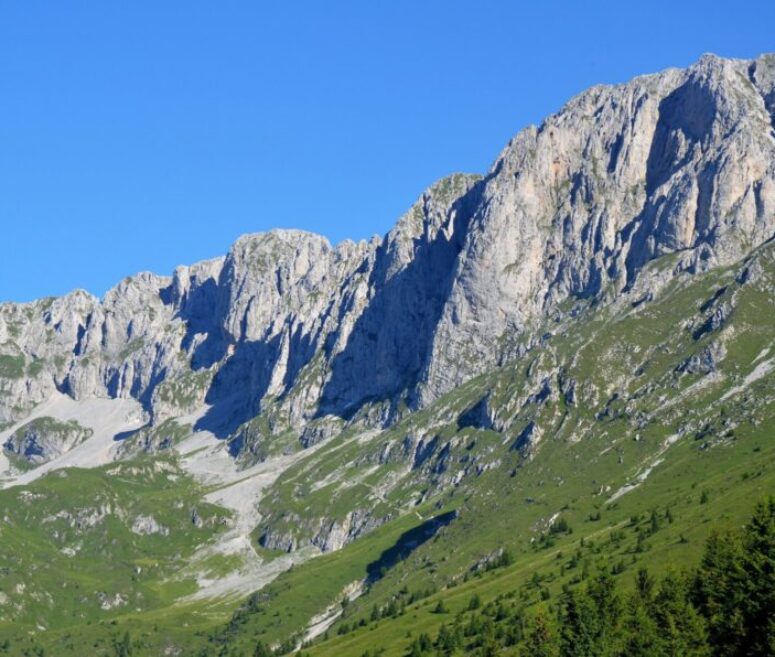Cara Montagna (Dear Mountain) is a correspondence. A gesture of return, of listening, of proximity. It is to write a letter knowing that, in this case, the answer, if it comes, will be made of wind, silence, marmots or eagles, the smell of the forest, the roar of water.
The first episode of this podcast series is about being on the move. Moving through space with your feet, in contact with the ground, means activating a slow and sensitive form of thinking, listening to the landscape and its deep rhythms. As mountaineer and writer Erling Kagge writes in his book Walking, ‘walking is losing time to gain space’ – a minimal act that returns us to the dimension of the present.
Cara Montagna (Dear Mountain) will soon be online. In anticipation of its launch, we publish the transcript of the conversation between Ilaria Gadenz and Elena Biserna, one of the voices of this first appointment.
Elena Biserna (1982) is an artist and PhD in audiovisual studies. Her interests focus in particular on expanded sound, listening and contextual, ephemeral, participatory practices in their intersections with urban dynamics, the everyday sphere and socio-cultural processes.
Among his most significant projects, Walking from Scores explores notation as an invitation to action in relation to walking and movement, conceived as privileged ways of interacting with context and everyday life. The project translates into a collection of “instructions for walking”, in which listening, space, body and gesture are interwoven. The title itself deliberately plays with Working from Scores, the text written by Ken Friedman in 1990. Friedman reflects on the processual and open nature of the work of art, comparing it to a musical score.
The walk can also be read in this way: a temporal score, a living choreography that takes shape in relation to context, body, time.
Cara Montagna (Dear Mountain) is a podcast produced by Ilaria Gadenz, created with Valentina Gervasoni.
ELENA BISERNA
Walking is now recognized as an accepted artistic gesture in art practices and theories, but initially it was not. It has been used by artists to step outside art spaces, to address different audiences, to enter the everyday and the social sphere. It is a way of being present, visible and audible in public space.
In the 1960s, many artists began walking as a gesture of re-appropriation of public space, of sharing and criticism of academic disciplinary rigidity. Walking crosses dance, theatre, performing arts, music, visual arts, becoming a meeting point between practices and people who want to question the boundaries of artistic disciplines.
The first artistic excursions may be found as early as the historical avant-gardes. The famous Dadaistwalk in Saint-Julien-le-Pauvre is an example of this: a guided tour that took participants to places “with no reason to exist,” as opposed to tourist Paris. It is an early departure from the idea of the representation of walking towards concrete action. The Surrealists also explored the nocturnal walk, but it was in the 1960s that a real climate of interdisciplinary relations was created. There is an interest in ordinary and infra-ordinary action that runs through dance (with Merce Cunningham and Anna Halprin), literature, visual arts, music. There is an attempt to break out of traditional representation and media, to criticize art institutions and their commercial spaces.
Walking becomes a constant practice for those who want to work with new audiences, outside the commercial circuits. What interested me was filling a historiographical gap: there is a lot of literature on walking in the visual arts, much less in sound and listening practices. And when people talk about listening and walking, they almost exclusively mention the sound walk canonized by the World Soundscape Project. I have tried to connect other forms, other genealogies. For example, the works of Dennis Oppenheim or Adrian Piper of those years, in which walking is intertwined with recording, open up a wide and non-linear field of practices that link walking, listening and sound production in public space.
ILARIA GADENZ
The research that goes into your Walking, Listening and Soundmaking is very much related to urban space; the practices you list happen in an urban context in most cases. I invited you to talk about mountains, however, and I wonder: what happens if we replace the idea of “street” with that of “path,” and “urban space” with “natural space”? Is there a bibliography that deals with nature as public space? Can we speak of “publicness” also in natural environments?
ELENA BISERNA
This is a very interesting question. In my opinion, it is not only possible to consider non-urban spaces as public spaces, but even necessary. At a time in history when ecocide is imminent, it is essential to reclaim the public character of nature and its “commons” dimension, even in environments like the mountains. So it seems to me necessary to imagine that the mountains constitute a space to be appropriated just as much as the town square.
I think we need to look a little more at literature in the field of critical ecology, but I also think it is useful to look at non-Western knowledge, at forms of relating to nature that colonial modernity tried to erase in territories such as North America, Central and South America, or Australia. These knowledges propose alternative ways of inhabiting and traversing natural space, unlike our cartographic and objectifying vision of space.
ILARIA GADENZ
Yes, it seems to me that compared to Western epistemology, the knowledge of space that emerges from indigenous knowledge and epistemologies is always linked to a planetary, mythopoeic thought, to a spirituality that goes beyond the idea of public space that emerged with the constitution of modern, Western man. So I find it interesting that you talk about nature as commons, but I find the idea of reappropriating the mountain equally problematic.
ELENA BISERNA
Of course, it is a re-appropriation aimed at the preservation of the wilderness. For too long we have not felt a relationship with these spaces: we have reduced them to tourist spots. We go skiing, but we don’t feel part of the mountain ecosystem. We do not feel the connection between that landscape and our bodies, our lives.
The failure to recognize our relationship with the land is linked to the way we have constructed ourselves as urban dwellers, with a relationship of domination towards nature. This leads us to destroy the land, or at least tolerate its destruction. Indigenous peoples, on the other hand, have never lost this connection.
To give an example, last summer I travelled to Mexico and spent a lot of time in the mountains. In mountain villages, the relationship with the land is one of total identification and embodiment. It is a deeply affecting experience, because it challenges our Western way of inhabiting natural space.
ILARIA GADENZ
In your book, you recount many experiences, paths, protocols. I was not familiar with the Collective Actions Group: it seems to me one of the few out-of-town examples. Is that so?
ELENA BISERNA
I would also like to emphasize Albert Mayr’s project, which is in the book. It was staged in the mountains around Bolzano. Mayr worked a lot on the sound walk, with great attention to rhythm and the relationship between space, time, and listening.
The project is called A Harmonic Trail in the Alps: a harmonic path, marked by panels installed along the route, which form a sort of score in the landscape. The idea is to scan the path in time, suggesting different modes of activation: alternating phases of contemplation and assimilation, of conversation and silence. It is an open, interpretative score.
ILARIA GADENZ
Back to the mountains: walking in the mountains is very much linked, in our context, to the history of mountaineering, which is a recent history, not even three hundred years old, and in any case a modern, diaristic and cartographic history of conquest. A history of anthropic control and appropriation. Is it possible to problematize this history?
In your book, you relativize the idea of the walker who is not a universal subject. Who can walk, how they can walk, is not a given. In the same way, I am very interested in the idea of sound as a medium that permeates the planimetric space of the map and complicates it, a research that I think you tackled years ago with the idea of the soundborderscape…
ELENA BISERNA
I was reminded of a very nice book I read on this subject: Do Glaciers Listen? The title is a question—“Do Glaciers Listen?”—and it is an investigation into the relationship between the first European colonizers in North America and the knowledge of the native peoples. It shows well how European explorers carried an imaginary of conquest and appropriation, in stark contrast to indigenous epistemologies based on co-dependence with the land. There are also references to listening. It is also a very interesting text in relation to sound research and the podcast Dear Mountain / Cara Montagna that you are producing.
On the question of the universality of the walking body: the literature on walking is vast, interdisciplinary, and often emphasizes the relational character of walking as a way of acquiring an embodied and situated knowledge, of rewriting urban space, or of claiming the public dimension of space, as Rebecca Solnit puts it.
Then there is the emphasis on the emancipatory value of walking, as a practice of citizenship, as a democratic practice, as a practice that is accessible and gives access to spaces. It is a narrative I have shared for a long time. But at some point I began to wonder: who can walk? How can s/he walk? What is the walking body? And I began to question this idea of the walker as a universal figure.
Walking is deeply related to the body, to the politics of bodies in the public sphere and at the same time to the various geopolitical realities, to the various contexts in which we can walk. It depends on a range of identities or identifications including gender, sexual orientation, whether one has certain documents or not, weight, age, health status, whether one’s body is considered able-bodied and fit, or racialization. Not all bodies can walk everywhere at all times. And not all territories are equally accessible.
There are fundamental texts on this, such as those by Garnette Cadogan, who recounts how risky it is for a racialized person to walk at night in a white supremacist society: one automatically becomes a suspect, subject to police scrutiny and the distrustful gaze of others.
There are historical examples, such as that of Abdelhafid Khatib, an Algerian, the only racialized member of the Situationist International. He was not able to complete the psycho-geographical mapping of Paris because, at that time—we are in the 1960s—a curfew intervened that prevented racialized people and in particular people of North-African origin from going out in the evening, and thus became a genuine moment of segregation of a part of the Parisian population. An emblematic case of how walking can be prevented for political and racial reasons.
This is an area I have tried to work on; I have also started a project called Feminist Steps: a continuation of Walking from Score. These are night walks with groups of women and non-binary people, designed to overturn assignments such as silence/visibility, presence/invisibility, through scores written by myself and Pauline Oliveros.
Then there is also a book that a colleague lent me: Méfiez-vous des femmes qui marchent (“Don’t trust women who walk”), which brings together many stories of women walkers in the mountains.
ILARIA GADENZ
With respect to this last point, I was thinking about how much the contemporary narrative of women in the mountains, as well as those in radio, in electronic music risks reiterating the cliché of the pioneer, of confirming that these bodies are exceptional because they are outsiders to the environments they want to conquer… And have you ever read Jennifer Lynn Stoever’s The Sonic Color Line? She talks about how sound and voice were used in the politics of racial profiling over the airwaves, in 1940s American radio…
ELENA BISERNA
Yes, I do. And by the way, I happened to be refused an interview on the radio in France because of my Italian accent.
ILARIA GADENZ
There is an interesting phenomenon studied by Katie Moylan, it is called “accenting” and refers to those radio practices, which through “accented” productions articulate diasporic identities, marginalized to resist the homogenizing and dominant linguistic canon of BBC-style English. It is a resistant strategy, to claim one’s identity through voice.
ELENA BISERNA
I was not familiar with the term accenting, but I find it very powerful. As a non-native speaker, I feel strongly about language control in the media and beyond. Claiming one’s accent can become an anti-nationalist act, against the nation-state model. A beautiful example is that of community radio…
ILARIA GADENZ
Back to the relationship between listening and walking, we talked about relationality, embodied knowledge…
ELENA BISERNA
The first link between walking and listening is precisely relationality. Walking brings us into relation with the territories we cross, and listening constantly exposes us to others and the world. Sound is vibration; it passes through us and makes us porous, vulnerable.
This vulnerability can become a basis of identity, a way to declare ourselves in co-dependence and interdependence with the spaces and living beings, human and non-human, with which we coexist. For me, it is the core of the practice of listening and also of walking: exposing ourselves, letting ourselves be crossed, recognizing fragilities, living and inhabiting vulnerability as a form of knowledge.





